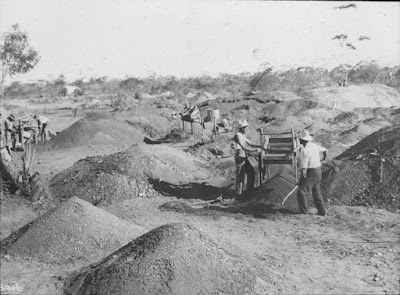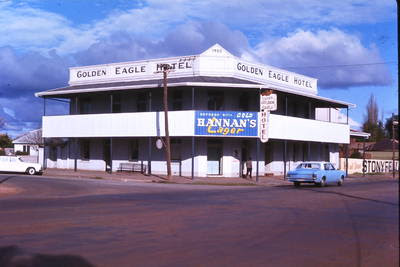Gold Mining at Larkinville in 1930's. Aussie~mobs:https://www.flickr.com/photos/70994841@N07/41697853000
The worldwide Depression of the late 1920s and early 1930s left Australia desperate for something to boost both the economy and public morale. Gold production had reached its lowest ebb. The industry in Australia employed 70,943 men in 1901: by 1929 the number had fallen to 6,095. Production costs had risen to such an extent that low-grade mining was unprofitable. A change was desperately needed.
In June 1930 a delegation made up of men from the leading gold mining centres of Australia went to Canberra. They persuaded Prime Minister Scullin's Labor Government to pay a yearly bonus of £1 per 30 grams for all gold produced over the average yield of the previous three years.
The success of the delegation was attributed mainly to mining promoter Claude de Bernales' 'perseverance, enthusiasm and refusal to give up the cause'. De Bernales lived in Kalgoorlie at the time and on his return was feted at a civic reception held in his honour. He told the gathering that he would 'urge mine owners and miners to unite their forces in the endeavour to get the bonus which would only be available by mass production'. He then announced that he was going to England to invite investment from that country, confident that the lure of the bonus would ensure his success.
With the new incentive, companies began upgrading their mining equipment. In Kalgoorlie, the Lake View and Star mines allocated £388,000 for a new flotation plant while the Associated Northern company made plans to reopen its mines at Ora Banda. Other companies and prospectors began planning and looked with interest at some of the 4,000 abandoned leases listed at the Western Australian Mines Department.
The gold bonus was mostly responsible for triggering off the mining revival. In 1931, Britain abandoned the gold standard and the price of gold to rose from £4 9s 4d in 1930 to £7 5s 5d in 1932, which further stimulated the gold mining sector.
However, the discovery of the Golden Eagle at the beginning of 1931 stirred men's imaginations and gave them hope in the dark days of the Depression. The Golden Eagle was found in Western Australia's Widgiemooltha field and was one of Australia's most enormous masses of gold. This field had been worked spasmodically since the early days of Coolgardie, so the find proved there was still gold to be discovered if one looked hard enough.
Early in 1930, a group of men was prospecting on this ground, 90 kilometres south-east of Coolgardie (this distance was reduced when a new road was built). Larkinville was named after Mick Larkin, who was credited with being the original prospector in the area. Other men searching at the same time were brothers Pat and Jack Hehir, Bill Mathieson, and Bob Clough.
These men worked hard in the area for some time, dryblowing and loaming with some little success. Late in the year, they unearthed a 37-gram slug, and they found other nuggets of various sizes. When Clough discovered a narrow reef and obtained 6220 grams from 40 tonnes of dirt, other men flocked to the area.
Some men unearthed a few large nuggets. Early in January 1931, Dan Brown picked up a nugget weighing 2490 grams, a record that was soon exceeded by McWhinney and mate's discovery of a 3420-gram nugget. Despite this, the area was not classed as being a 'tucker' or 'poor man's field'. Like the old Kurnalpi field, a few men picked rich nuggets and others found nothing.
Finding gold is always a gamble. Bill Sheehan was disappointed with a block he held at Larkinville so abandoned it to Jim Larcombe, president of the Coolgardie Prospectors' Association. On the afternoon of 15 January 1931, Jimmy Larcombe's seventeen-year-old son, was digging down about 45 centimetres into the red loam when his pick hit something hard. When he prised the object out of the ground and saw what it was, 'he let out a terrific yell, and the diggers nearby quickly ran to the spot to see the lad staggering about with the massive slab of gold in his arms'.
The men weighed it on a pole against a 27- kilogram bag of sugar, and the gold was heavier. Young Larcombe had unearthed Western Australia's record nugget, named the Golden Eagle, because of its resemblance to an eagle in flight. The piece of gold was 66 centimetres long, 30 centimetres wide, and 8 centimetres thick, and weighed 35 325 grams. The discovery brought a general feeling of renewed hope, particularly to Western Australians, and men flocked to Larkinville in their hundreds.
January 1931, The Golden Eagle Nugget in Kalgoorlie. https://collections.museumvictoria.com.au/items/767878
The alluvial field was a magnet that drew the unemployed hoping to strike it rich. They ignored the many Press warnings that it was inadvisable to prospect there without considerable financial backing. Reports of real distress among some of the unlucky diggers soon reached Kalgoorlie. Jim Larcombe appealed to the Kalgoorlie Miner to set up a fund to help these men, some of them existing on nothing but porridge. The Kalgoorlie Miner quickly established the Larkinville Distress Fund and drew a good response. Larcombe's nugget was put on display in the Kalgoorlie Town Hall. Hundreds of adults and children happily paid 1s 6d to view the wonderful Golden Eagle, which raised a sizeable amount of money.
Many other prospectors had come with proper backing and equipment. One example was the 'Tramway' prospectors. Two parties of eight men financed by their tramway workmates in Perth went out to look for gold in the Larkinville area. Like many other newcomers, they were forced to look farther afield and tried their luck around the St Ives area. The only reward they received, however, was the result of a crushing from a mediocre reef found in the district.
A month after the Larcombes found the Golden Eagle, there were 1,000 men on the Larkinville field and more arriving daily. They pegged the ground for kilometres around. The camp soon became a canvas town with a post office, dining-rooms, and stores providing various services. The residents participated in a weekly concert and played football and cricket against teams from the neighbouring mining camps of St Ives and Widgiemooltha.
The population of the district fluctuated, with disappointed prospectors leaving and hopeful men arriving. Nine months after the discovery of the Golden Eagle, only about 100 to 150 men remained on the field.
A few reefs were uncovered, but the only one of any consequence was the Ground Lark which produced some 99,000 grams of gold from 2,068 tonnes of ore.
Jim Larcombe would have had a chance of becoming a millionaire if he had been able to keep his find instead of selling it as the law required. Wirth's Circus offered him £20,000 to take the Golden Eagle on tour. At that time it was forbidden to own gold in Australia, so Larcombe sold the nugget to the State Government for £5,438.
The nugget was sent to the eastern States to stimulate interest in mining there, but a plan to exhibit it in England fell through. On 2 November 1931, The Minister for Mines (Mr Scaddin), told members of the Legislative Assembly that the Golden Eagle had been sold to the Commonwealth Bank. It was sold for £6,520 and was smelted down at the Perth Mint. The Government made a profit from the transaction.
Like many other prospectors who struck it rich, James Larcombe bought a hotel. He purchased the Terminus Hotel in Boulder with money from the sale of the wonderful find. He renamed the hotel the Golden Eagle.
The hotel was damaged by an earthquake in April, 2010. It remained damaged and disused until it burned down in May 2012, a few weeks prior to it's planned demolition. It was located on the corner of Lane and Wittenoom Streets
The Golden Eagle Hotel in 1969.
Destroyed by Fire, The Golden Eagle Hotel. https://www.abc.net.au/news/2012-05-08/fire-destroys-boulder-blaze-in-goldfields/3997346
This article was first published in Norma King's "Colourful Tales of the Western Australian Goldfields" as 'Once Again, Gold Came to the Rescue' by Rigby in 1980.
https://www.perthnow.com.au/news/wa/kalgoorlies-110-year-old-golden-eagle-hotel-burnt-down-ng-46133e10de53e80da7bcd8777446e75f #Larcombe #Larkinville




No comments:
Post a Comment